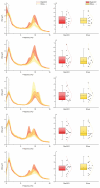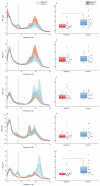Surface EEG Evidence for Cerebellar Control of Distal Upper Limbs in Humans
- PMID: 40426610
- PMCID: PMC12109835
- DOI: 10.3390/brainsci15050440
Surface EEG Evidence for Cerebellar Control of Distal Upper Limbs in Humans
Abstract
Background/Objectives: The cerebellum plays a crucial role in motor control, but its direct electrophysiological investigation in humans is challenging. Electrocerebellograms (ECeGs), recorded via surface electrodes below the inion, have been proposed as a non-invasive method to assess cerebellar activity. However, its interpretation is complicated by potential interference from occipital alpha rhythms and neck muscle signals. This study aimed to investigate whether ECeG signals genuinely reflect cerebellar involvement during upper limb movement and to explore possible confounding influences. Methods: We recorded electroencephalograms (EEGs) from occipital (Oz) and cerebellar electrodes (Cb1 and Cb2), alongside EMGs from forearm muscles in healthy individuals performing sinusoidal (~1 Hz) and tremor-like (~4 Hz) wrist movements. To assess occipital contamination, recordings were obtained under both eyes-open and eyes-closed conditions. Results: Occipital alpha power was present in Cb1 and Cb2 but was less affected by eye-opening than at Oz, suggesting a partially distinct neural source. During the tremor condition, movement-frequency power increased at Cb2 and C3 (corresponding to the ipsilateral cerebellar hemisphere and contralateral motor cortex), indicating authentic cerebellar activity. No significant movement-related EEG changes were observed during sinusoidal movements, likely due to weaker neuronal synchronization. Conclusions: These findings suggest that ECeGs can detect cerebellar signals linked to movement, especially during faster and rhythmic motions, and are only moderately affected by occipital contamination. This supports the feasibility of non-invasive cerebellar electrophysiology and underscores the need for further methodological refinement to enhance signal specificity.
Keywords: alpha rhythm; cerebellum; electrocerebellogram; electroencephalography; motor cortex; sinusoidal movements; tremor.
Conflict of interest statement
The authors declare no conflicts of interest.
Figures






Similar articles
-
The human electrocerebellogram (ECeG) recorded non-invasively using scalp electrodes.Neurosci Lett. 2018 Aug 24;682:124-131. doi: 10.1016/j.neulet.2018.06.012. Epub 2018 Jun 15. Neurosci Lett. 2018. PMID: 29886131
-
Distinct movement related changes in EEG and ECeG power during finger and foot movement.Neurosci Lett. 2025 Mar 28;853:138207. doi: 10.1016/j.neulet.2025.138207. Epub 2025 Mar 19. Neurosci Lett. 2025. PMID: 40118369
-
Altered Cerebellar Oscillations in Parkinson's Disease Patients during Cognitive and Motor Tasks.Neuroscience. 2021 Nov 1;475:185-196. doi: 10.1016/j.neuroscience.2021.08.021. Epub 2021 Aug 26. Neuroscience. 2021. PMID: 34455014
-
Can EEG and MEG detect signals from the human cerebellum?Neuroimage. 2020 Jul 15;215:116817. doi: 10.1016/j.neuroimage.2020.116817. Epub 2020 Apr 8. Neuroimage. 2020. PMID: 32278092 Free PMC article. Review.
-
How does the brain create rhythms?Ideggyogy Sz. 2010 Jan 30;63(1-2):13-23. Ideggyogy Sz. 2010. PMID: 20420120 Review.
References
-
- Manto M., Bower J.M., Conforto A.B., Delgado-Garcia J.M., da Guarda S.N., Gerwig M., Habas C., Hagura N., Ivry R.B., Marien P., et al. Consensus paper: Roles of the cerebellum in motor control—The diversity of ideas on cerebellar involvement in movement. Cerebellum. 2012;11:457–487. doi: 10.1007/s12311-011-0331-9. - DOI - PMC - PubMed
LinkOut - more resources
Full Text Sources
Miscellaneous

